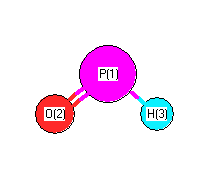Vibrational levels (cm-1) 
| Mode Number |
Symmetry |
Frequency |
Intensity |
Comment |
Description |
| Fundamental(cm-1) |
Harmonic(cm-1) |
Reference |
(km mol-1) |
unc. |
Reference |
| 1 |
A' |
2095 |
|
VEEL5 |
|
|
|
|
|
| 2 |
A' |
1188 |
|
VEEL5 |
|
|
|
|
|
| 3 |
A' |
986 |
|
VEEL5 |
|
|
|
|
|
vibrational zero-point energy: 2134.3 cm
-1 (from fundamental vibrations)
Calculated vibrational frequencies for
HPO (Hydrogen phosphorus oxide).
Geometric Data

Point Group Cs
Internal coordinates
distances (r) in Å, angles (a) in degrees, dihedrals (d) in degrees
Cartesians
| Atom |
x (Å) |
y (Å) |
z (Å) |
| P1 |
0.0578 |
-0.4888 |
0.0000 |
| O2 |
0.0578 |
1.0232 |
0.0000 |
| H3 |
-1.3283 |
-0.8525 |
0.0000 |
Atom - Atom Distances 
Distances in Å
| |
P1 |
O2 |
H3 |
| P1 |
|
1.5120 | 1.4330 |
| O2 |
1.5120 |
|
2.3322 |
| H3 |
1.4330 | 2.3322 |
|
Calculated geometries
for HPO (Hydrogen phosphorus oxide).
Experimental Bond Angles (degrees) from cartesians 
| atom1 |
atom2 |
atom3 |
angle |
| O2 |
P1 |
H3 |
104.700 |
Bond descriptions
Examples: C-C single bond, C=C, double bond, C#C triple bond, C:C aromatic bond
| Bond Type |
Count |
| H-P |
1 |
| O=P |
1 |
Connectivity
| Atom 1 |
Atom 2 |
| P1 |
O2 |
| P1 |
H3 |
Dipole, Quadrupole and Polarizability
Electric dipole moment 
| State |
Config |
State description |
Conf description |
Exp. min. |
Dipole (Debye) |
Reference |
comment |
Point Group |
Components |
| x |
y |
z |
total |
dipole |
quadrupole |
| 1 |
1 |
1A' |
Cs |
True |
|
|
|
|
|
|
Cs |
2 |
3 |
Experimental dipole measurement abbreviations: MW microwave; DT Dielectric with Temperature variation; DR Indirect (usually an upper limit); MB Molecular beam
Calculated electric dipole moments for
HPO (Hydrogen phosphorus oxide).
Electric quadrupole moment 
| State |
Config |
State description |
Conf description |
Exp. min. |
Quadrupole (D Å) |
Reference |
comment |
Point Group |
Components |
| xx |
yy |
zz |
dipole |
quadrupole |
| 1 |
1 |
1A' |
Cs |
True |
|
|
|
|
|
Cs |
2 |
3 |
Calculated electric quadrupole moments for
HPO (Hydrogen phosphorus oxide).











